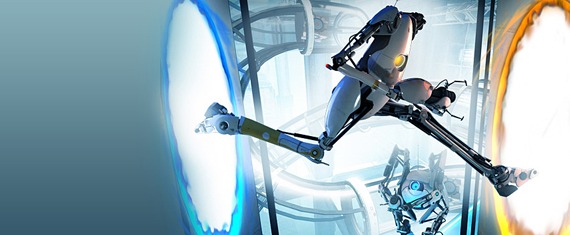 Portal was one of those “where the heck did this come from?” type of games when Valve shipped it as part of The Orange Box. Nothing quite like it had been done before, so reviewing Portal was a bit of a pain. Between its mix of brain-teasing puzzles, its unique physics-reliant portal gun and the brilliantly dry sense of humor of its narrator/boss GLaDOS, Portal wasn’t as much a “game” as it was an experience. Portal 2 continues the original’s model, both in terms of gameplay and humor, and reviewing it poses just as many challenges. So let’s just get this out of the way right now: Portal 2 is videogame nirvana for the thinking man. Or should I say “thinking people”? Because female gamers will also love this brain-teasing “shooter,” and half of Portal 2’s allure is its truly co-operative co-op modes.
Portal was one of those “where the heck did this come from?” type of games when Valve shipped it as part of The Orange Box. Nothing quite like it had been done before, so reviewing Portal was a bit of a pain. Between its mix of brain-teasing puzzles, its unique physics-reliant portal gun and the brilliantly dry sense of humor of its narrator/boss GLaDOS, Portal wasn’t as much a “game” as it was an experience. Portal 2 continues the original’s model, both in terms of gameplay and humor, and reviewing it poses just as many challenges. So let’s just get this out of the way right now: Portal 2 is videogame nirvana for the thinking man. Or should I say “thinking people”? Because female gamers will also love this brain-teasing “shooter,” and half of Portal 2’s allure is its truly co-operative co-op modes.
The gameplay in Portal 2 is essentially identical to the original, with a few tweaks that refine the level navigation. Through a series of “tests” in a dilapidated scientific facility, players must solve increasingly challenging puzzles about how to activate certain levers and “teleport” themselves around obstacles on their way to the finish line. This teleportation is achieved by using a gun that shoots a blue portal and an orange portal on the wall, floor or ceiling, with the caveat that players can have only one of each color active at any given time. For instance, if you shoot an orange portal on the wall and a blue portal on the ceiling, when you walk through the orange portal you’ll fall down from the roof via the blue portal. But, if you shoot the blue portal on a wall at the other end of the level instead, you’ll end up walking through that blue doorway instead — perhaps avoiding some nasty lasers or un-crossable reservoirs in the process.
In Valve’s original game it could be challenging to recall exactly where you’d placed your portals, which led to some frustrating falls and checkpoint restarts. In Portal 2, Valve has made the small but meaningful addition of an on-screen indicator that shows where each portal is located. It sounds like a minor change, but considering some of the puzzles cooked-up for the later levels (of which there are more than 30), those reminders are really helpful.
As you move through each level, the diabolical AI named GLaDOS — who is accidentally reconstructed by a dimwitted-but-friendly robot guide early in the game — brings some levity to the mental exercises with a wry sense of humor infused with the sentiments of a scorned lover. The way GLaDOS pokes fun at your physique, mocks your inability to solve challenges quickly and recounts the heartless way you killed her in the first game, GLaDOS really feels like a character. In some respects, you develop a connection with her akin to the one forged with Halo’s Cortana, but on a deeper level. And yes, GLaDOS even pulls a few practical jokes.
A few levels in Portal 2, including one or two of the later ones, are a breeze, but the game still elicits more feeling of accomplishment than most of the so-called hardcore games. To be fair, that’s somewhat dependent on personal preference; I enjoy brainteasers as much as I do fragging someone. But it’s a safe bet that most older and mature gamers (no, those aren’t always the same thing) will find plenty of pride in solving each test’s puzzle and walking into the next testing chamber.
It’s not just walking a cube around the level and calling it good; Valve created barriers at some points that don’t allow inanimate objects to pass through. It’s not just shooting a portal across the level and walking to the end; Valve placed laser-activated switches that require gamers to strategically position light-splitting cubes, which in and of themselves have a puzzle associated with getting them to the desired location. Portal 2 taxes parts of the brain that few games even recognize. And I can’t thank Valve enough for that.

As rewarding as the single-player experience may be, it’s the co-op in Portal 2 where things really take off. Portal 2 co-op supports two players both online and via split-screen play, and it requires truly cooperative play. Each player has two unique portal colors, much like in the single-player game, but each player can (and must, at times) create portals for the other player, effectively giving the team four portals to solve each level’s puzzles. In some cases the cooperative play is as simple as passing a cube to the other person through a window to get around an obstacles, but generally it’s more along the lines of creating cross-level portals to exchange items or making sure you’re in the right place to activate the appropriate lever so the other person can pass through his or her barrier.
In most cooperative shooters, teammates communicate by shouting at one another mid-firefight or assigning roles before the level starts. In Portal 2, which is a “shooter” only because players shoot a portal gun, gamers can calmly talk strategy mid-puzzle and through the use of a Ping Tool. The Ping Tool lets players inform their robotic partner about any and all important areas. For instance, you can use the Ping Tool to indicate where you want your teammate to place a portal, where to pickup or drop a cube, or where he or she should stand in order to activate a switch for you or to grab an item you’re about to drop via your own portals. Portal 2’s co-op mode could have easily delved into the mundane “activate my switch for me” type of gameplay, but it’s much deeper than that, and the ability to use your portals to help your teammate advance is cool.
The only snafus with Portal 2 are of the online variety, and they’re (ideally) going to be short-lived. Playing Portal 2 cooperatively for this review, for instance, was done via split-screen play. When I tried to play online via the PlayStation Network, the PSN kicked me the same connection errors that have been plaguing the service for at least a week now. Presumably, and hopefully, Sony’s working on a fix, but so far it’s not been possible to play Portal 2 online for co-op puzzle solving. This also has meant I haven’t been able to tie the PS3 version of Portal 2 with my PC Steam account, one of the cool features of Portal 2 that Valve announced last week. For such an innovative connection, not having the requisite online connectivity is a huge loss, and I’m sure Valve is on the warpath somewhere at PSN headquarters for having their new gaming baby suffer a total buzzkill. Once it’s resolved, though, you’ll definitely want to take advantage of the voucher code included in the PS3 retail copy that allows you to download Portal 2 on a PC or Mac, too. Not only is it a “free” game, but it’ll save your progress on any computer and let you pick right back up where you left off next time you log on.
Those online issues are clearly Sony problems, though, and not tied into Portal 2 itself. Yes, they detract from the co-op experience, but it’s not in the least bit fair to downgrade Portal 2 for a problem the developers didn’t even create. As a result, I’ll come right out and say that Portal 2 is my favorite game so far in 2011, with the caveat that those PSN issues had better get resolved quickly. If they don’t, Portal 2 won’t be nearly the success it could be, and not nearly as many people will pick it up. And believe me, Portal 2 is one game every PS3, Xbox 360 and PC gamer should experience for themselves.
You can buy Portal 2 from Amazon.com using these links: Portal 2 for PS3, Portal 2 for Xbox 360
and Portal 2 for PC/Mac
.
Score: 9.5
Platform reviewed: PlayStation 3
